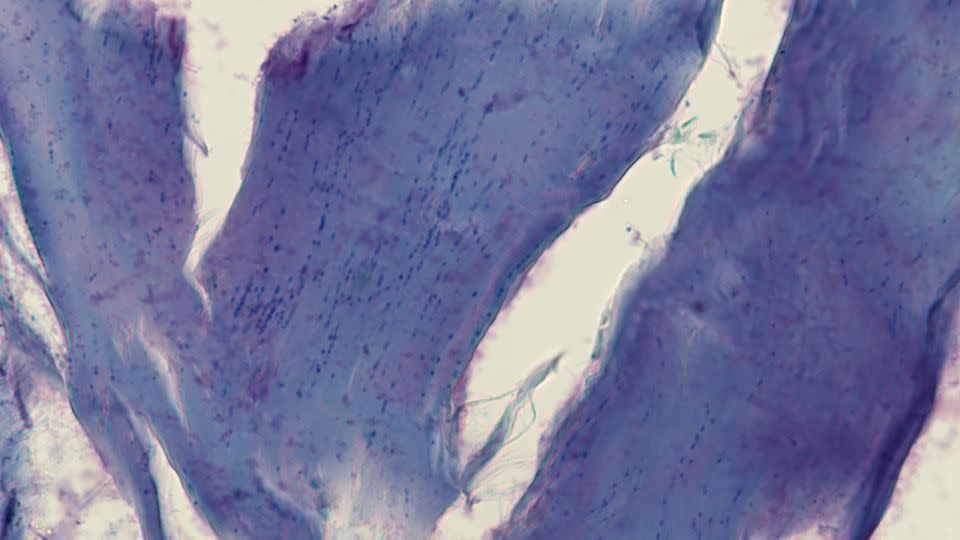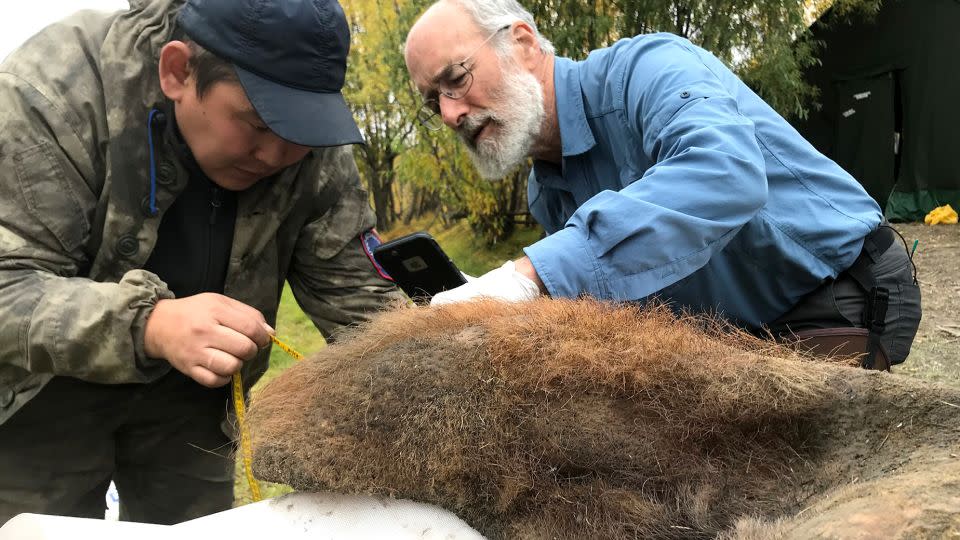Sign up for CNN’s Wonder Theory science newsletter. Explore the universe with news about fascinating discoveries, scientific developments and more.
A piece of woolly mammoth skin excavated from the permafrost of Siberia contains fossil chromosomes, the first discovery of its kind, a new study shows.
Researchers unearthed the 52,000-year-old remains in 2018 near the village of Belaya Gora in northeastern Siberia, where freezing temperatures helped preserve in detail the structure of chromosomes — tiny thread-like structures that carry genetic material, or DNA.
Although ancient DNA samples have been found many times before, they are usually very fragmented, containing only hundreds of letters of genetic code. Fossil chromosomes contain millions, which gives a much more complete picture of an animal’s genetic code.
“Fossil chromosomes have never been found before,” said Erez Lieberman Aiden, a professor of molecular and human genetics at Baylor College of Medicine and a co-author of the study published Thursday in the journal Cell.
In previous findings, the fragments also lacked an organized structure, Lieberman Aiden added. “Here, the fragments are clearly arranged in 3D — essentially as they were in the original chromosomes in the living mammoth.”
The chromosomes, which the researchers call “non-mineralized fossils or subfossils,” are in a state of preservation good enough to assemble the genome, or the sum of all genetic material, of an extinct species, said Olga Dudchenko, an assistant professor of molecular and human genetics at Baylor College of Medicine and co-first author of the study.
“We strongly believe that this is not just true for the mammoth or this particular mammoth,” said Dudchenko, who is also a senior researcher at the Center for Theoretical Biological Physics at Rice University, “but that it actually opens up a new field of study with enormous potential.”

DNA diffusion
According to Kevin Campbell, a professor of environmental and evolutionary physiology at the University of Manitoba in Canada, the DNA in different cell types is organized into distinct and specific 3D structures that provide insight into the specific properties or characteristics of that cell type. He was not involved in the research.
At death, body cells degrade rapidly and this 3D structure is lost in a few days or less, he added. In Arctic animals such as the woolly mammoth, the degradation is slower because of the freezing temperatures, but the DNA still becomes damaged and over time is expected to lose the structure and properties that shape the biology of the species.
“However, this study is the first to show that this is not necessarily always the case,” Campbell said in an email.
“DNA is a very, very long molecule, and once it sits there after an animal dies, it starts to break down and get chopped into shorter pieces,” Dudchenko said.
“What you normally expect is that all these pieces will start to shift relative to each other and just float away, losing any organization that was there,” Dudchenko said. “But in this particular example, that clearly didn’t happen.”
This loss of structure is called diffusion, and how to prevent it is well known to food scientists. It’s not all that different from making beef jerky, she added.


“Stopping diffusion is the key to preserving food, so if you want something that has a long shelf life, you basically need a combination of dehydration and refrigeration,” she said. “Any shelf-stable food that’s not canned is probably in a state of diffusion arrest.”
When the mammoth from which the skin sample came died, conditions may have been just right for this process to occur naturally. “(The carcass) could have spontaneously undergone the same procedure that we use commercially all the time now,” Dudchenko said, “removing significant amounts of water, stopping diffusion inside, and locking those bits of chromosomes in place, allowing us to read them out 52,000 years later.”
But while it was well preserved, the DNA wasn’t completely intact. “Each chromosome, originally one DNA molecule, has fragmented into millions of DNA molecules,” Aiden said in an email. “But the molecules haven’t moved around all that much, even on the nanometer scale, which is why we call it a fossil chromosome.”
If this sample were a book, Lieberman Aiden said, the binding would have disappeared, leaving behind a large number of unbound pages or DNA fragments. Diffusion is like the wind that blows the pages away, making it impossible to put them back in their proper order. But in this sample, the pages never blew away; they remained in a neat pile, just as they had been before the binding was lost.
Shooting beef jerky
The researchers confirmed this theory of preservation by conducting a series of experiments on dried beef. They wanted to see how much they could abuse the meat snack before the chromosomes in it lost their structure.
“We decided to test how well this beautiful molecule can withstand stress and damage by having one of the Houston Astros pitchers throw a fastball at it and fire a shotgun at it,” said Dr. Cynthia Pérez Estrada, co-first author of the study and a researcher at Baylor’s Center for Genome Architecture and Rice’s Center for Theoretical Biological Physics.
“The dried meat broke more and more, but the DNA structure was still there, which told us that DNA is extremely resistant and even more so in this kind of glassy state (as in the sample), where the molecules are basically frozen and behave like a crystal,” added Pérez Estrada.
Using the newly discovered genetic information in the skin samples, the researchers were able to determine for the first time that the woolly mammoth had 28 pairs of chromosomes, just like modern elephants.
But the structure allowed them to go a step further and see which individual genes were active in the animal. “Everyone wants to know what exactly made it woolly,” Dudchenko said, “and we have some ideas because of the way these chromosomes are preserved.”
Mammoth dreams
The researchers were able to compare individual genes from the mammoth sample to the equivalent genes in modern elephants, noting differences in the activity of genes that regulate hair follicles. But the elephant DNA was also needed to assemble the mammoth genome.
“Our dream and hope was to fully assemble the mammoth genome, but right now we’re not quite there yet — we’ve still been using some information from its closest relatives to help, because the amount of data we could get from the mammoth was lower than what you normally need,” Dudchenko said. “But the basic principles tell us that if we keep working on this, we can do it (without the help of elephant DNA).”
Could fossil chromosomes make the dream of resurrecting the woolly mammoth a reality? “The fundamental biology that we learn from this will be useful, there’s no doubt about it,” Dudchenko said. “Are we closer? One step closer, but there are still many steps to go and all sorts of considerations beyond the basic science.”
The researchers hope that the methodology used on the mammoth sample can also be applied to samples from other species.


“We hope to find chromosome structures in museum specimens,” said Marcela Sandoval-Velasco, a visiting researcher at the Center for Evolutionary Hologenics at the University of Copenhagen in Denmark and co-first author of the study. “Not just permafrost specimens, because that really limits it, but also samples from museum collections. There’s huge potential there,” she added, citing the woolly rhinoceros, extinct lions and the passenger pigeon as some of the extinct species scientists could learn more about this way.
According to Pérez Estrada, that potential opens the door to further discoveries.
“It’s going to take a huge effort to find suitable samples, so there’s still a lot of work to do — but I wouldn’t be surprised if we discover something new and completely different from what we have now,” she said. “That’s also a really exciting open question: What and what other physical properties (of DNA) can be preserved?”
Exciting findings
Researchers not involved in the study were also enthusiastic about the findings.
The study is the first to reconstruct the structure, or architecture, of a genome from an extinct species that lived during the last ice age, said Peter Heintzman, a paleogeneticist at Stockholm University in Sweden. “This structural information provides insights into features of the woolly mammoth genome that were invisible with previous genomic methods,” Heintzman said in an email. “This advance therefore helps open up a new and exciting frontier in paleogenomics, the study of ancient genomes, and will likely provide greater insight into how extinct species evolved, lived and became extinct.”
According to Dmitry Filatov, a professor of biology at the University of Oxford in the United Kingdom, it was surprising to see how much the DNA of ancient samples is typically degraded and fragmented. That is why this study presented a high-quality reconstruction of the mammoth genome at the chromosome level.
“What is even more surprising is that the researchers were able to deduce which genes were active and which were turned off in the mammoth sample and compare this with gene expression in elephants,” Filatov said in an email. “This will certainly stimulate further paleogenomic research in other species.”
Hendrik Poinar, director of the Ancient DNA Centre at McMaster University in Ontario, called the paper “super exciting.” Normally, researchers can’t come close to assembling a genome using fossil remains, Poinar said.
“I don’t know how many tissue samples will have this level of preservation,” he added in an email, “but I do think the method will make us think about new ways to extract DNA from tissues in ways that are different from what we’re used to.”
For more CNN news and newsletters, create an account at CNN.com